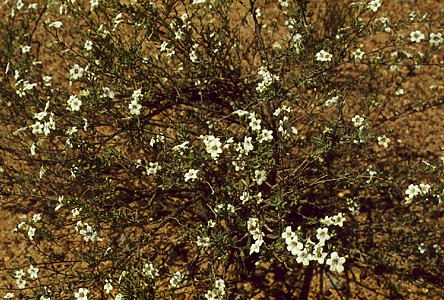 Voucher: Haegi 1211 . Photo: L. Haegi © L. Haegi |
 Close-up of flowers (Haegi 1936 ). Photo: L. Haegi © L. Haegi |
 Line drawing by M. Perkins (from L.Haegi, unpubl. thesis). |

Synonymy
Cyphanthera racemosa (F. Muell.) Haegi, Telopea 2: 177 (1981)
Anthocercis racemosa F. Muell., Fragm. Phytogr. Austral. 1: 211 (1859).
T: Between Murchison River and Port Gregory, W.A., Oldfield s.n.; syn: K, MEL.
Description
Shrub to 1.2 m. Branches usually sparsely tomentose with non-glandular hairs.
Leaves narrowly elliptic, oblong or obovate, sessile or almost so, 5–25 mm long, 1.5–4.5 mm wide, sparsely tomentose; juvenile leaves larger, slightly fleshy.
Inflorescence thyrse-like; pedicels 4–20 mm long. Calyx 2–7 mm long, glabrous or pubescent, often tinged purple. Corolla 7–18 mm long, pubescent outside, white, the striations purple; lobes usually ovate to elliptic, 3–11 mm long, papillose inside. Stamens 3–5.5 mm long.
Capsule ovoid-ellipsoid, 3.5–5 mm long. Seeds 1.6–2.5 mm long.
Distribution and ecology
Occurs in south-western W.A. near the W coast, between the lower Murchison R. and Corrigin.
Grows in shrubland and scrub-heath on sand plains and coastal dunes; often common after fire.
Notes
Populations in the far south-eastern range of distribution have a dense tomentum and rounded corolla lobes.
Phylogeny
Phylogenetic studies by Garcia & Olmstead (2003) on the Tribe Anthocercideae using two chloroplast DNA regions included this species The studies indicated that Cyphanthera is not monophyletic. Cyphanthers odgersii showed a closer relationship to Grammosolen while the rest of the Cyphanthera species combined to form a clade with Duboisia and Crenidium.
Reference: V.F.Garcia & R.G.Olmstead (2003). Phylogenetics of Tribe Anthocercideaea (Solanaceae) based on ndhF and trnL/F sequence data. Systematic Botany 28: 609-615.
Selected specimens
W.A.: c. 160 km (N) from Geraldton on NW Coastal Highway, A.M. Ashby 2178 (AD, PERTH); 60 km SE of Geraldton, L. Haegi 1936, (BRI, CANB, NSW, PERTH); Kalbarri National Park, G.L. Webster 18621 (NSW).
Derivation of epithet
From Latin racemosa, a reference to the arrangement of the flowers in a raceme.
Images and information on web
Images of C. racemosa can be seen on the Western Australian Herbarium Florabase site at http://florabase.calm.wa.gov.au/browse/photo?f=315&level=s&id=6959
Pharmacology: A discussion of the tropane alkaloids which occur in Cyphanthera and other Anthocercideae can be found in Griffith & Lin (2000).
Ref: W.J. Griffin & G.D. Lin (2000). Chemotaxonomy and geographical distribution of tropane alkaloids. Phytochemistry 53: 627–628.
Plant status (if any)
Without any declared rating in W.A. – see http://florabase.calm.wa.gov.au/conservationtaxa